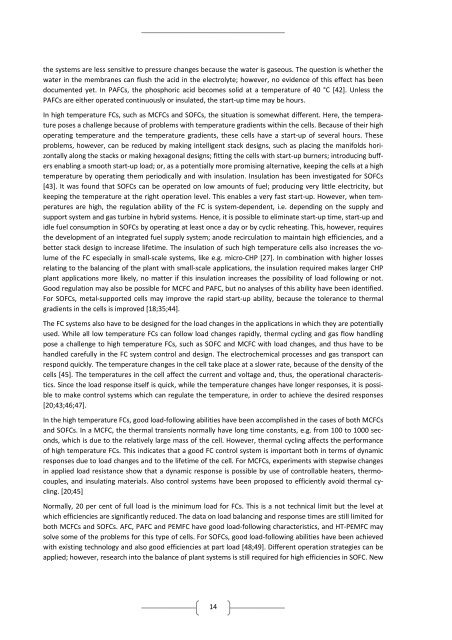Fuel cells and electrolysers in future energy systems - VBN
Fuel cells and electrolysers in future energy systems - VBN
Fuel cells and electrolysers in future energy systems - VBN
Create successful ePaper yourself
Turn your PDF publications into a flip-book with our unique Google optimized e-Paper software.
the <strong>systems</strong> are less sensitive to pressure changes because the water is gaseous. The question is whether the<br />
water <strong>in</strong> the membranes can flush the acid <strong>in</strong> the electrolyte; however, no evidence of this effect has been<br />
documented yet. In PAFCs, the phosphoric acid becomes solid at a temperature of 40 °C [42]. Unless the<br />
PAFCs are either operated cont<strong>in</strong>uously or <strong>in</strong>sulated, the start‐up time may be hours.<br />
In high temperature FCs, such as MCFCs <strong>and</strong> SOFCs, the situation is somewhat different. Here, the tempera‐<br />
ture poses a challenge because of problems with temperature gradients with<strong>in</strong> the <strong>cells</strong>. Because of their high<br />
operat<strong>in</strong>g temperature <strong>and</strong> the temperature gradients, these <strong>cells</strong> have a start‐up of several hours. These<br />
problems, however, can be reduced by mak<strong>in</strong>g <strong>in</strong>telligent stack designs, such as plac<strong>in</strong>g the manifolds hori‐<br />
zontally along the stacks or mak<strong>in</strong>g hexagonal designs; fitt<strong>in</strong>g the <strong>cells</strong> with start‐up burners; <strong>in</strong>troduc<strong>in</strong>g buff‐<br />
ers enabl<strong>in</strong>g a smooth start‐up load; or, as a potentially more promis<strong>in</strong>g alternative, keep<strong>in</strong>g the <strong>cells</strong> at a high<br />
temperature by operat<strong>in</strong>g them periodically <strong>and</strong> with <strong>in</strong>sulation. Insulation has been <strong>in</strong>vestigated for SOFCs<br />
[43]. It was found that SOFCs can be operated on low amounts of fuel; produc<strong>in</strong>g very little electricity, but<br />
keep<strong>in</strong>g the temperature at the right operation level. This enables a very fast start‐up. However, when tem‐<br />
peratures are high, the regulation ability of the FC is system‐dependent, i.e. depend<strong>in</strong>g on the supply <strong>and</strong><br />
support system <strong>and</strong> gas turb<strong>in</strong>e <strong>in</strong> hybrid <strong>systems</strong>. Hence, it is possible to elim<strong>in</strong>ate start‐up time, start‐up <strong>and</strong><br />
idle fuel consumption <strong>in</strong> SOFCs by operat<strong>in</strong>g at least once a day or by cyclic reheat<strong>in</strong>g. This, however, requires<br />
the development of an <strong>in</strong>tegrated fuel supply system; anode recirculation to ma<strong>in</strong>ta<strong>in</strong> high efficiencies, <strong>and</strong> a<br />
better stack design to <strong>in</strong>crease lifetime. The <strong>in</strong>sulation of such high temperature <strong>cells</strong> also <strong>in</strong>creases the vo‐<br />
lume of the FC especially <strong>in</strong> small‐scale <strong>systems</strong>, like e.g. micro‐CHP [27]. In comb<strong>in</strong>ation with higher losses<br />
relat<strong>in</strong>g to the balanc<strong>in</strong>g of the plant with small‐scale applications, the <strong>in</strong>sulation required makes larger CHP<br />
plant applications more likely, no matter if this <strong>in</strong>sulation <strong>in</strong>creases the possibility of load follow<strong>in</strong>g or not.<br />
Good regulation may also be possible for MCFC <strong>and</strong> PAFC, but no analyses of this ability have been identified.<br />
For SOFCs, metal‐supported <strong>cells</strong> may improve the rapid start‐up ability, because the tolerance to thermal<br />
gradients <strong>in</strong> the <strong>cells</strong> is improved [18;35;44].<br />
The FC <strong>systems</strong> also have to be designed for the load changes <strong>in</strong> the applications <strong>in</strong> which they are potentially<br />
used. While all low temperature FCs can follow load changes rapidly, thermal cycl<strong>in</strong>g <strong>and</strong> gas flow h<strong>and</strong>l<strong>in</strong>g<br />
pose a challenge to high temperature FCs, such as SOFC <strong>and</strong> MCFC with load changes, <strong>and</strong> thus have to be<br />
h<strong>and</strong>led carefully <strong>in</strong> the FC system control <strong>and</strong> design. The electrochemical processes <strong>and</strong> gas transport can<br />
respond quickly. The temperature changes <strong>in</strong> the cell take place at a slower rate, because of the density of the<br />
<strong>cells</strong> [45]. The temperatures <strong>in</strong> the cell affect the current <strong>and</strong> voltage <strong>and</strong>, thus, the operational characteris‐<br />
tics. S<strong>in</strong>ce the load response itself is quick, while the temperature changes have longer responses, it is possi‐<br />
ble to make control <strong>systems</strong> which can regulate the temperature, <strong>in</strong> order to achieve the desired responses<br />
[20;43;46;47].<br />
In the high temperature FCs, good load‐follow<strong>in</strong>g abilities have been accomplished <strong>in</strong> the cases of both MCFCs<br />
<strong>and</strong> SOFCs. In a MCFC, the thermal transients normally have long time constants, e.g. from 100 to 1000 sec‐<br />
onds, which is due to the relatively large mass of the cell. However, thermal cycl<strong>in</strong>g affects the performance<br />
of high temperature FCs. This <strong>in</strong>dicates that a good FC control system is important both <strong>in</strong> terms of dynamic<br />
responses due to load changes <strong>and</strong> to the lifetime of the cell. For MCFCs, experiments with stepwise changes<br />
<strong>in</strong> applied load resistance show that a dynamic response is possible by use of controllable heaters, thermo‐<br />
couples, <strong>and</strong> <strong>in</strong>sulat<strong>in</strong>g materials. Also control <strong>systems</strong> have been proposed to efficiently avoid thermal cy‐<br />
cl<strong>in</strong>g. [20;45]<br />
Normally, 20 per cent of full load is the m<strong>in</strong>imum load for FCs. This is a not technical limit but the level at<br />
which efficiencies are significantly reduced. The data on load balanc<strong>in</strong>g <strong>and</strong> response times are still limited for<br />
both MCFCs <strong>and</strong> SOFCs. AFC, PAFC <strong>and</strong> PEMFC have good load‐follow<strong>in</strong>g characteristics, <strong>and</strong> HT‐PEMFC may<br />
solve some of the problems for this type of <strong>cells</strong>. For SOFCs, good load‐follow<strong>in</strong>g abilities have been achieved<br />
with exist<strong>in</strong>g technology <strong>and</strong> also good efficiencies at part load [48;49]. Different operation strategies can be<br />
applied; however, research <strong>in</strong>to the balance of plant <strong>systems</strong> is still required for high efficiencies <strong>in</strong> SOFC. New<br />
14

















